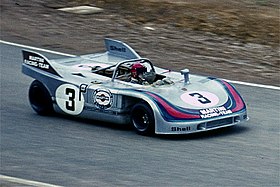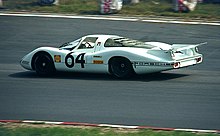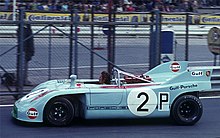| This article needs additional citations for verification. Please help improve this article by adding citations to reliable sources. Unsourced material may be challenged and removed. Find sources: "Porsche 908" – news · newspapers · books · scholar · JSTOR (April 2018) (Learn how and when to remove this message) |
You can help expand this article with text translated from the corresponding article in German. (June 2018) Click for important translation instructions.
|
| Porsche 908 | |
|---|---|
 Porsche 908/3 of 1971 Porsche 908/3 of 1971 | |
| Overview | |
| Manufacturer | Porsche |
| Production | 1968–1971 |
| Designer | Helmuth Bott (chassis) Hans Mezger (engine) |
| Body and chassis | |
| Class | 1966-1971: Group 6 prototype-sports car 1972-1975: Group 5 sports car 1976-81: Group 6 two-seater racing car |
| Body style | Coupé spyder |
| Layout | RMR |
| Powertrain | |
| Engine | 3.0 L flat 8 (908/01, 02, 03) 2.1 L turbocharged flat 6 (908/03) |
| Dimensions | |
| Length | 4,839 mm (190.5 in) |
| Curb weight | 650 kg (1,430 lb) |
| Chronology | |
| Predecessor | Porsche 907 |
| Successor | Porsche 936 |
The Porsche 908 was a racing car from Porsche, introduced in 1968 to continue the Porsche 906-Porsche 910-Porsche 907 series of models designed by Helmuth Bott (chassis) and Hans Mezger (engine) under the leadership of racing chief Ferdinand Piëch.
As the FIA had announced rule changes for Group 6 prototype-sports cars limiting engine displacement to 3,000 cc, as in Formula One, Porsche designed the 908 as the first Porsche sports car to have an engine with the maximum size allowed. The previous Porsche 907 only had a 2,200 cc Type 771/1 flat-eight engine developing 270 PS (199 kW). The new 3-litre Type 908 flat-eight produced 350 PS (257 kW) at 8,400 rpm. Being traditionally air-cooled and with only two valves per cylinder, it still had less power compared to more modern F1 designs which delivered over 400 hp (300 kW), but were not suited to endurance racing.
The 908 originally was a closed coupe to provide low drag at fast tracks, but from 1969 on was mainly raced as the 908/2, a lighter open spyder. A more compact 908/3 was introduced in 1970 to complement the heavy Porsche 917 on twisty tracks that favored nimble cars, like Targa Florio and Nürburgring. Sold off to privateers for 1972, various 908s were entered until the early 1980s, often retro-fitted with Porsche 934-based 2.1-litre turbocharged flat-six engines.
908/01 (1968)
Despite winning the 1000km Nürburgring, the 908 was anything but convincing in 1968. The older and smaller 2200 cc 907 had started the season with dominating wins and later delivered better results than Porsche's first serious attempt in the prototype category. Meanwhile, the older 4.7-litre Ford GT40s Group 5 sports cars were winning races on the faster tracks, while the Ford P68 being a failure, Ferrari remaining absent, and the Alfa Romeo 33 still utilizing a 2,000 cc engine. With the minimum production requirement for the 5,000 cc Group 5 sports car category reduced from 50 units to 25 for 1969, Porsche decided to go one step further and build the required 25 examples of a new 12-cylinder car, the Porsche 917. This risky investment was expected take about a year, though, and the 908 was supposed to deliver results in the meantime.
The 1968 24 Hours of Le Mans was postponed from June to the end of September due to political unrest in France, setting the stage for a showdown between the 908s and the GT40s. The Porsche 908 LHs (long tails) were the fastest in qualifying and the early stages of the race, but it showed that Porsche had not taken advantage of the additional time to improve the 908. Troubles with the alternator caused delays and even disqualifications as the new Porsche team leaders had misinterpreted the repair rules. Once again, a V8-powered Ford won, and a 907 LT came in second in front of the sole surviving standard 908. In addition, Ford won the 1968 International Championship for Makes.
908/02 (1969)


For 1969, the Group 6 prototype rules were changed, and Porsche lowered the weight of the Porsche 908/02 spyder by 100 kg (220 lb), removing the roof and the long tails. Aluminium tube frames were used, with air pressure gauges to check them.
The 1969 24 Hours of Daytona was a disaster for Porsche, as all three 908/02 failed, while a Lola T70 won. At the 12 Hours of Sebring, a Ford GT40 defeated a trio of factory-entered 908/2s.
At that time, the more powerful Porsche 917 was introduced in Geneva, and it seemed that the career of the 908 was over, but the 908 started to succeed. The next race was the BOAC 500 at Brands Hatch, where the 908 was finally successful, finishing 1-2-3 ahead of a Ferrari 312P. With additional wins at the 1000km Monza, the Targa Florio, the 1000km Spa and an overwhelming 1-2-3-4-5 at the 1000 km Nürburgring, the 1969 International Championship for Makes was secured for Porsche by the 908/02, while the Porsche 917 suffered problems.
However, the prestigious 24 hours of Le Mans was again won by a Ford GT40 in 1969, as the 917s had gearbox troubles after leading for many hours. A 908 challenged for the win, as Hans Herrmann came in as a very close second, behind Jacky Ickx. Herrmann's 908 low drag coupé was fast on the straights, but near the race's end the brake pads wore down, indicated by a light that was introduced with the 908s. The team gambled on not changing the pads, which allowed Ickx to pass under braking. The 908/02 in which Steve McQueen finished second at the 1970 12 Hours of Sebring was also used as a camera car for the Le Mans film in the race itself. McQueen originally intended to drive a Porsche 917 in the race, though this was vetoed by the studio funding the film.
908/03 (1970)


Despite the more powerful 917 improving towards the end of 1969, the career of the 908 continued for the 1970 World Sportscar Championship. On rather twisty and slow tracks like Nürburgring and Targa Florio, the 917 was not suited well even after being modified to the "917K". So rather than trying to make "one size fit all", Porsche built dedicated cars for each type of racing track. Based upon the lightweight and short Porsche 909 which was used in hillclimbing, the new open cockpit version, the 908/03, was even shorter than the 908/02, and only weighed 500 kg (1,100 lb) - very light for a long-distance racing car. By comparison, the 917K weighed about 840 kg (1,900 lb). The 908/03 was so short that the driver's legs projected ahead of the front wheels.
In May 1970, this version, in fact the very same chassis #008, was successful in the 1970 Nürburgring 1000 km and the Targa Florio, where typical speeds were only about half of the top speed of 240 mph (390 km/h) which the 917LH long tails could achieve at Le Mans. At the Targa, the car was given to JWA, painted in Gulf blue and as #12 with two red arrows, driven by Jo Siffert / Brian Redman to victory. Other 908/03 came in 2nd, 4th and 5th, with one DNF, and two only used for training due to lack of drivers. In addition, an old 908/02 was entered by Martini.
Four weeks later at the Ring, #008 was entered by Porsche Salzburg as plain white #22, with Vic Elford and Kurt Ahrens leading a 1-2 finish after two JWA had crashed out, with no less than four 908/02 coming 4-5-6-7.
For the 1971 World Sportscar Championship, vertical fins were added not only to the fast 917K but also to the rear of the 908/03 which sported larger roll bars. One week after the Spa 1000km, with already five wins for Zuffenhausen, and two weeks before the 1971 1000km of Nürburgring were the 908/03 were needed again, less effort than usual was invested and only three 908/03 were brought to Sicily, and that number proved too low - or too high. All entered 908/03s crashed (the two JWA on the first lap; Brian Redman was badly injured after a fiery crash), but Vic Elford in the Martini-entered #008 did manage to set the fastest lap and was classified 39th despite a late crash. Winner of the 71' Targa Florio was local hero Nino Vaccarella leading a 1-2 by Alfa Romeo and their Tipo 33s, with Gijs van Lennep driving the 2nd place Alfa instead of a fourth 908 before driving for Porsche again two weeks later, and winning the 1971 Le Mans in the Martini 917K four weeks later.
Within two weeks, two crashed 908/03 had to be fixed, and the totalled car of Redman as well as the hospitalized driver had to be replaced, with a fourth chassis needed to give JWA and Martini two good cars each. All German cars arrived late at the Ring which had been resurfaced, while the Italians were going fast. The single Ferrari 312PB of Jacky Ickx and Clay Regazzoni was on pole by no less than 9 seconds and led the race for six laps when engine troubles started. The still bumpy Ring also broke engine mounts in the JWA-908 of Siffert/Bell, with Siffert continuing in the other JWA car of Rodriguez. The sole fast Alfa of Stommelen/Galli led until lap 14 in which the engine failed, followed by the same fate for the leading Ferrari in lap 21 of 44. "Quick" Vic Elford had been hunting them in the air-cooled two valve Martini-908 chassis #008 which had less power than the V12. The race saw a 1-2-3 finish for the surviving works 908/03 in front of two less competitive Alfas and a private 917K. One of the several private Ferrari 512S finished 9th among three private 908/02.
With Alfas scoring wins at Brands Hatch and Watkins Glen, and Ferrari developing the 312PB, it was proven that these nimble three litre prototypes could beat the 917s also outside of the Targa.
With the combination of the powerful 917 and the lightweight 908 in various variants, entering two factory backed teams plus supporting privateers and GT cars, Porsche dominated the International Championship for Makes each year from 1969 to 1971. With new rules in effect in 1972, large engine "sportscars" like the 917 were no more allowed, and a high minimum weight for prototypes negated the main advantage the 908/03 had. Porsche sold some to privateers.
1972 - 1981


For 1972, the 5,000 cc Group 5 sports car category was discontinued, and the 917 and its main rival, the Ferrari 512, became obsolete, as did Lola T70, Ford GT40 and others. In the 3,000 cc category, renamed "Group 5 sports cars", Porsche's main advantage had been their low weight, as the engine was underpowered with 370 PS (272 kW). The new rules required a much higher weight (650 kg (1,430 lb)) than Porsche could achieve (well under 600 kg (1,300 lb)), giving the advantage to the Ferrari 312PB, Alfa Romeo T33TT and Matra with their more powerful F1-derived V12 engines that had 420 hp (310 kW) or more, even in endurance trim.
Porsche decided to end its 20-year history of factory sports car racing and sold the 908/03 cars to customers. Besides developing the 917/10 turbo for the Can Am series, the Zuffenhausen-based company focused on the development of the already aging Porsche 911, testing the 911 flat-six with turbochargers. Yet a three-year-old Porsche 908LH coupé was entered by Reinhold Joest in the 1972 24 Hours of Le Mans, finishing third. Customers continued to race several 908/03s, fitted with extra weight as required by the rules. In 1975, some 908s were fitted with turbocharged engines, similar to those used in the Porsche 934 GT car, but downsized. Even with 2.1-litre and a turbo factor of 1.4, the turbos by now outpowered normally aspirated 3-litre engines. Taking advantage of that, in 1976 the factory developed the Porsche 936 to compete in the new Group 6 two-seater racing car category that replaced the Group 5 sports car class. Unlike the 934 and 935, Porsche did not offer the 936 for sale, entering it in a few races only, mostly at Le Mans. Several customer 908s were upgraded with 936-style bodywork, though. The Porsche 908/80 turbo of Joest and Ickx, which finished second in the 1980 24 Hours of Le Mans, turned out later to have a real Porsche 936 chassis.
The 908 won the 1000 km Nürburgring in three different decades, winning four years in a row from 1968 to 1971 and again in 1980, utilizing turbocharging for its final victory. Some 908s are still raced currently in competitions such as the Classic Endurance Racing (CER) series.
Versions
908 LH coupé 1968
- 2,990 cc 8-cyl engine
- 350 PS (257 kW)
- Top speed: 320 km/h (200 mph)
- Closed cockpit
- Long tail bodywork for fast tracks
908/02 spyder 1969
- 2,990 cc 8-cyl engine
- 350 PS (257 kW)
- Top speed: 290 km/h (180 mph)
- Open cockpit
- Low weight (no minimum weight given by rules)
- Short tail bodywork for twisty and slow tracks
908/03 spyder 1970-1971
- 2,990 cc 8-cyl engine
- 370 PS (272 kW)
- Top speed: 290 km/h (180 mph)
- Open cockpit
- Shorter wheelbase
- Lower weight
- New bodywork, also with rear fins in 1971
908/03 Spyder turbo 1975-1981
- 1971 factory cars sold to customer teams
- Modified by teams and in factory
- 2,140 cc 6-cyl turbo engines
- Over 500 hp
References
- "Porsche 908/02 Spyder Pictures". DieselStation. Retrieved 30 July 2010.
- Robson, Graham (December 2004). "Brian Redman". Octane. Vol. 2, no. 18. p. 106.
- https://www.racingsportscars.com/chassis/photo/908__03-008.html
- https://www.ultimatecarpage.com/img/Porsche-908-03-6845.html
External links
| Porsche | |||||||
|---|---|---|---|---|---|---|---|
| Volkswagen Group marques & companies | |||||||
| Cars |
| ||||||
| Tractors | |||||||
| Motorsport |
| ||||||
| Engines and technologies | |||||||
| People |
| ||||||
| See also |
| ||||||